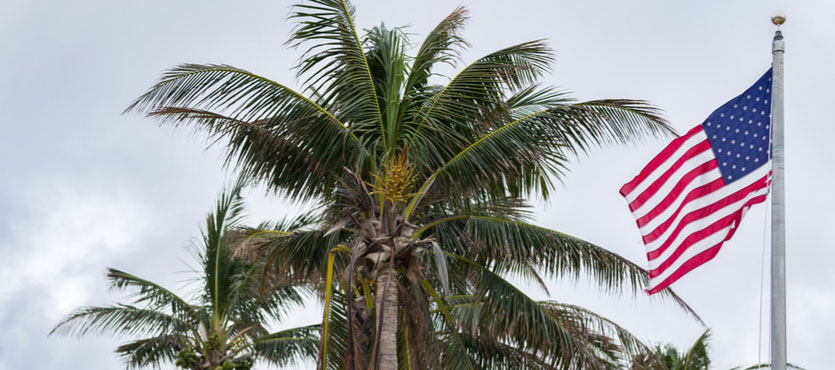The beautiful queen palm (Syagrus Romanzoffianum) is also known as the feather palm and presents a stately and graceful tropical feel to any landscape. This palm features long shimmery fronds and a regal gray trunk that adds lushness to South Florida landscapes. The fronds often reach more than 10 feet in length and the queen palm can grow to nearly 40 feet, producing flowers that result in clusters of small dates.
The queen palm grows a single trunk making it ideal for single or group planting. The palm can also be used as an anchor for a bed or a grouping of smaller palms in home or business landscaping. Because it has a fast growth habit, medium and larger plants can flourish at its base. Plants like hibiscus, bush allamanda, copper plant, selloum philodendron, Cape Tecoma honeysuckle, and Burgundy loropetalum are excellent choices to highlight the majestic queen palm.
Queen Palm Characteristics
As mentioned, queen palms are fast growers, climbing to heights of 30 to 40 feet quickly. Because of their fast growth, they are considered an excellent selection for those who want a beautiful mature landscape without the wait.
Queens are considered moderately cold hardy which means they can thrive in USDA growing zones 9B to 11. These palms love the warm humid clients of South Florida where they prosper with relatively low maintenance in lighting from full sun to partial shade.
Queen palms are moderately drought and salt tolerant making them a great choice for South Florida landscapes. These palms look lovely when planted in rows or groupings, but due to their growth rate and mature height, they should be planted four to five feet apart.
Taking Proper Care of Queen Palm Trees
When planting queen palms, organic peat moss or top soil should be added. Newly planted queens should be watered daily until established. Adult palms should be watered slowly and deeply to a soak the soil two to three feet and around the trunk to a width of five feet. During the summer months, watering should be done regularly every seven to 10 days, decreasing in winter to every three to four weeks. This schedule should be adjusted for rainfall. Though the queen palm is relatively drought tolerant, it still requires regular watering.
To fertilize queen palms, use a specialty mix (with the needed nitrogen, potassium, magnesium, and other micronutrients) developed for palms. Application should be done in mid-spring into summer at the rate recommended on the fertilizer. To apply, scatter the fertilizer evenly on the soil, away from the trunk, and then water deeply.
Remove loose fronds, cutting off those which are damaged, diseased, or dead as well as dates which can hang over walkways. Queen palms can be pruned twice a year while the fronds are in reach. Once your queens reach a certain height (making it dangerous to prune), you should consider hiring a professional to handle pruning and maintenance. Leave all green fronds in place, even those with discolored tips, never cutting those that are growing horizontally or vertically.
Your queen palm should be sprayed with a garden hose or soaker regularly to rid it of damaging mites and other insects in the fronds. In addition, cleaning rids palms of dust and if you live near the ocean, salt build-up on the fronds.
Xtreme Landscaping is here with the tips and tricks needed to help you add queen palms to your landscape and take care of them with irrigation and fertilization.

